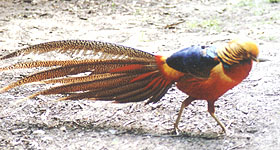As a small boy leafing through books on exotic birds from faraway lands, I recall being awe-stuck by a bird that, to me, symbolized all that was wild, foreign, beautiful and unknown – the golden pheasant (Chrysolphus pictus). The long-tailed males, which display gold, deep red, rust, blue, tan, orange, green, scarlet, yellow and chestnut feathers, are among the most richly-colored of all birds.
Beautiful and Tough
 I was indeed amazed to learn, years later, that these central China natives are among the most commonly kept of all pheasants, and were quite reasonably priced.
I was indeed amazed to learn, years later, that these central China natives are among the most commonly kept of all pheasants, and were quite reasonably priced.
Furthermore, although brilliant plumage had always signaled “delicate” to my inexperienced mind, golden pheasants are amazingly tough birds. Evolved to endure frigid winters in mountainous habitats, an open-sided shelter easily saw them through New York winters. In fact, hot summers prove more of a threat.
Natural History
Golden and the closely related Lady Amherst’s pheasants (C. amherstiae) are also called ruffed pheasants, due to the brilliant cape that encircles the nape. Courting males raise the ruff and leap about the hens, first on one side, then the other. Some populations appear to be monogamous, but most observers report that males mate with 6-8 hens in the wild.
Golden pheasants are native to the highlands of central and northwestern China, where their range overlaps with that of a familiar US transplant, the ring-necked pheasant. Shy and wary, it is said that the males’ striking colors are visible over great distances on clear days.
Captive History and Care
Goldens may be the earliest pheasants to have been taken into captivity, and have been well known in East Asian aviculture for centuries. They were brought to North America in the mid 1700’s, and were reportedly kept by George Washington.
Experienced aviculturists often recommend golden pheasants as excellent starter species. They adjust well to modestly sized outdoor aviaries and invariably become exceedingly tame. A trio that I kept was as confiding as chickens, even while nesting. Although usually kept in pairs, a trio or male and 3 hens is preferable, as males often drive a single hen incessantly and interfere with rearing the chicks.
Golden pheasants have been hybridized with cheer, silver, Reeve’s, Caucus and green pheasants, and even with domestic hens! Only golden/Lady Amherst crosses are consistently fertile, however.
Further Reading
You can read more about golden pheasants in the wild at http://www.gamebird.com/pheasantgolden2.html.
Image referenced from Wikipedia and first posted by Magnus Manske.
 That Bird Blog – Bird Care and History for Pet Birds
That Bird Blog – Bird Care and History for Pet Birds
